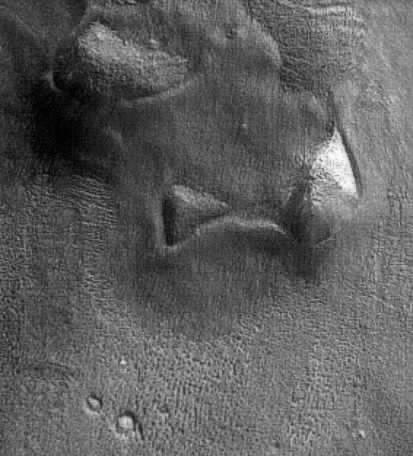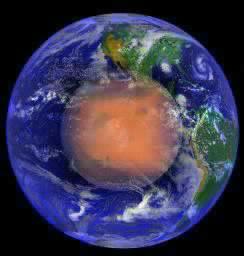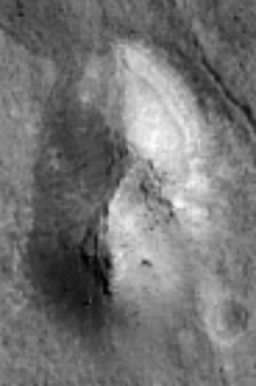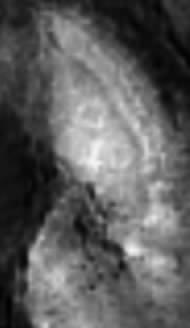

Cydonia Quest
C
Image Enhancements
C
Bright Mound "E"
On the Viking pictures of Cydonia the "Bright Mounds" are a distinctive array of mounds that overlap with the southern half of the Cydonia "City". Hoagland, Torun, Crater and McDaniel noted that the "Bright Mounds" were so arranged that they formed a series of triangles which seemed suspiciously close to ones specifically connected with tetrahedral geometry. Dr. Horace Crater further established through computer simulations that even when large margins of error were applied to the positions of the mounds, these geometrical arrangements were very improbable. Keith Morgan also found that the two Bright Mounds analysed on this page (mounds "E" and "D") are aligned with other mounds to form an involute curve with tetrahedral properties in addition to forming part of a geometrically significant triangle.
Although I'm attempting to cover new features with these image enhancement pages, Bright Mound "E" has been noted on many other web sites. It has only been imaged once by the MGS at an extremely low resolution of 6.2 metres (or just over twenty feet) on image M09-05394. To put this into context, at this kind of resolution my own modest two storey dwelling might easily have been invisible to the MGS camera. So although Bright Mound "E" covers a greater ground area than the Great Pyramid of Giza, there is not much detail to be seen. There are similarities between "E" and the pyramidal formation on the southern edge of the West Formation (click here µµµ).
What there is to be seen is very interesting indeed, as shown in the accompanying image enhancement. Unlike the tumbledown remains of the other Bright Mounds that have so far been captured by the MGS, "E" has clean facets and sharp edges. It is clearly pyramidal and may be the partially collapsed remains of a five sided pyramid, much along the lines of the monster D&M Pyramid. It also lives up to the "Bright Mound" description in that it is brighter than its surroundings.

C
C
C
C
C
C
C
C
C
C
C
C
C
C
C
What is also surprising about "E" is the clean, sharp moat outlining some of its base. This effect is shared by a smaller, triangular mound nearby and a more formless heap of rubble. All three features seem to be located on a raised platform. Also note the strange array of pits on the plain overlooked by "E" which have a grill like arrangement. There are extensive areas of these "grills" on the plain between Bright Mounds "E" and "D". They have been captured at a higher resolution in another image and they will be analysed on another page.
If all of the Bright Mounds looked like "E" then I suspect many more people would be supporting the artificiality hypothesis.
C
Bright Mound "D"


After the clean "architectural" lines of Bright Mound "E", "D" comes as something of a disappointment. It is smaller than "E" and has been captured by the MGS at a resolution of 4.7 metres (or 15 feet) on image M04-01903. If "D" is a ruin then we can never be sure of what its original shape was. However, there are a few features in this formation that may be the exposed parts of an artificial interior.
The depression in the central right side of "D" in the accompanying images has two levels - and both levels seem to have rectilinear edges. The upper most side of the depression, as shown in the image below, appears to have some box like enclosures along its inner edge. (The reader can make any particular feature on this image of "D" clearer by adjusting the brightness and contrast on their own computer monitor as required).
The top right side facet of "D", as it appears in the image, also has some interesting features. It is surrounded by double bevelled edging. This is most pronounced at ground level, but the ridge line on the highest part of this facet exhibits the same effect in a smoother way. The surface of this facet has two intriguing square shapes outlined in a lighter colour upon it. Could these be part of a structural support grid that has been exposed by erosion? I have made a further enlargement of this area with a more extreme contrast to make these squares easier to see.
The original MGS images used for these enhancements of "E" and "D" can be found in 40% and 100% format at the following MSSS web page µµµ.


C
C
µ Next Page
µ Return to the Enhancements page